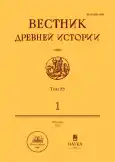‘CULTIC REFORMS’ OF THE KINGS OF JUDAH IN THE LIGHT OF ARCHAEOLOGICAL DATA
- Autores: Luppova A.A.1
-
Afiliações:
- Lomonosov Moscow State University
- Edição: Volume 85, Nº 1 (2025)
- Páginas: 18–44
- Seção: Articles
- URL: https://bakhtiniada.ru/0321-0391/article/view/307829
- DOI: https://doi.org/10.31857/S0321039125010025
- ID: 307829
Resumo
Palavras-chave
Sobre autores
A. Luppova
Lomonosov Moscow State University
Email: anyaluppova@mail.ru
Moscow, Russia
Bibliografia
- Aharoni, Y. 1967: Excavations at Tel Arad: Preliminary Report on the Second Season, 1963. Israel Exploration Journal 17, 233–249.
- Aharoni, Y. 1968: Arad: Its Inscriptions and Temple. Biblical Archaeologist 31/1, 2–32.
- Aharoni, Y. 1975: Excavations at Tel Beer-sheba: Preliminary Report of the Fifth and Sixth Seasons, 1973–1974. Tel Aviv 2, 146–168.
- Bienkowski, P. 2002: Busayra Excavations by Crystal-M. Bennett, 1971–1980. Oxford.
- Chapman, R. 1992: A Stone Toilet Seat Found in Jerusalem in 1925. Palestine Exploration Quarterly 124, 4–8.
- Davies, Ph.R. 2019: Josiah and the Law Book. In: L.L. Grabbe (ed.), The Hebrew Bible and History: Critical Readings. New York–London, 391–403.
- De Groot, A., Bernick-Greenberg, H. 2012a: Excavations at the City of David 1978–1985. Directed by Yigal Shiloh. Vol. VIIA. Area E: Stratigraphy and Architecture, Text. (QEDEM, 53). Jerusalem.
- De Groot, A., Bernick-Greenberg, H. 2012b: Excavations at the City of David 1978–1985. Directed by Yigal Shiloh. Vol. VIIB. Area E: The Finds. (QEDEM, 54). Jerusalem.
- Edelman, D. 2008: Hezekiah’s Alleged Cultic Centralization. Journal for the Study of the Old Testament 32/4, 395–434.
- Elitzur, Y. 2023: The Altar at Tel Dothan – A Trace of Josiah’s Reform? Journal of the Ancient Near Eastern Society 36/1, 62–89.
- Finkelstein, I., Silberman, N.A. 2006: Temple and Dynasty: Hezekiah, the Remaking of Judah and the Rise of the Pan-Israelite Ideology. Journal for the Study of the Old Testament 30/3, 259–285.
- Ganor, S., Kreimerman, I. 2019: An Eighth-century B.C.E. Gate Shrine at Tel Lachish, Israel. Bulletin of the American Schools of Oriental Research 381, 211–236.
- Ganor, S., Kreimerman, I. 2023: The Iron Age Inner City Gate and Gate Shrine at Tel Lakhish (Lachish). ‘Atiqot 111, 359–405.
- Gibson, Sh., Kennedy, T., Kramer, J. 2013: A Note on an Iron Age Four-horned Altar from Tel Dothan. Palestine Exploration Quarterly 145/4, 306–319.
- Herzog, Z. 1997: Tel ha-Me udoth be’Arad [The Arad Fortresses]. In: R. Amiran, O. Ilan, M. Sebbane, Z. Herzog (eds.), ‘Arad [Arad]’. Tel Aviv, 113–292.
- Herzog, Z. 2001: The Date of the Temple at Arad: Reassessment of the Stratigraphy and the Implications for the History of Religion in Judah. In: A. Mazar (ed.), Studies in the Archaeology of the Iron Age in Israel and Jordan. (JSOTSup, 331). Sheffield, 156–178.
- Herzog, Z. 2002: The Fortress Mound at Tel Arad: An Interim Report. Tel Aviv 29/1, 3–109.
- Herzog, Z. 2010: Perspectives on Southern Israel’s Cult Centralization: Arad and Beer-sheba. In: R.G. Kratz, H. Spieckermann (eds.), One God – One Cult – One Nation: Archaeological and Biblical Perspectives. Berlin–New York, 169–199.
- Herzog, Z., Aharoni, M., Rainey, A.F., Moshkovitz, Sh. 1984: The Israelite Fortress at Arad. Bulletin of the American Schools of Oriental Research 254, 1–34.
- Herzog, Z., Rainey, A.F., Moshkovitz, Sh. 1977: The Stratigraphy at Beer-sheba and the Location of the Sanctuary. Bulletin of the American Schools of Oriental Research 225, 49–58.
- Kisilevitz, Sh., Lipschits, O. 2020: Another Temple at Judah! The Tale of Tel Moza. Biblical Archaeology Review 46/1, 40–49.
- Kleiman, A., Cohen, M.E., Hall, E., Homsher, R.S., Finkelstein, I. 2017: Cult Activity at Megiddo in the Iron Age: New Evidence and a Long-Term Perspective. Zeitschrift des Deutschen Palästina-Vereins 133/1, 24–52.
- Kleiman, S. 2020: The Iron IIB Gate Shrine at Lachish: An Alternative Interpretation. Tel Aviv 47/1, 55–64.
- Liraz, E. 2018: A Second Cult Room at the Lachish Gate? Near Eastern Archaeology 81/4, 269–275.
- Mazar, A., Netzer, E. 1986: On the Israelite Fortress at Arad. Bulletin of the American Schools of Oriental Research 263, 87–91.
- Na’aman, N. 1995: The Debated Historicity of Hezekiah’s Reform in the Light of Historical and Archaeological Research. Zeitschrift für die alttestamentliche Wissenschaft 107/2, 179–195.
- Na’aman, N. 2002: The Abandonment of Cult Places in the Kingdoms of Israel and Judah as Acts of Cult Reform. Ugarit-Forschungen 34, 585–602.
- Pakkala, J. 2010: Why the Cult Reforms in Judah Probably Did not Happen. In: R.G. Kratz, H. Spieckermann (eds.), One God – One Cult – One Nation: Archaeological and Biblical Perspectives. Berlin–New York, 201–235.
- Römer, Th. 2005: The So-Called Deuteronomistic History: A Sociological, Historical and Literary Introduction. London.
- Singer-Avitz, L. 2002: Arad: The Iron Age Pottery Assemblages. Tel Aviv 29/1, 110–214.
- Uehlinger, Chr. 2019: Was There a Cult Reform under King Josiah? The Case for a Well-Grounded Minimum. In: L.L. Grabbe (ed.), The Hebrew Bible and History: Critical Readings. New York–London, 404–424.
- Ussishkin, D. 1988: The Date of the Judaean Shrine at Arad. Israel Exploration Journal 38/3, 142–157.
- Ussishkin, D. 1989: Schumacher’s Shrine in Building 338 at Megiddo. Israel Exploration Journal 39/3–4, 149–172.
- Ussishkin, D. 2004: Area GE: The Inner City-Gate. In: D. Ussishkin, The Renewed Archaeological Excavations at Lachish (1973–1994). Vol. II. The Iron Age Stratigraphy and Architecture. Tel Aviv, 624–689.
- Ussishkin, D. 2021: Was a “Gate Shrine” Built at the Level III Inner City Gate of Lachish? A Response to Ganor and Kreimerman. Bulletin of the American Schools of Oriental Research 385, 153–170.
- Vukosavović, F. 2023: Reconsidering Toilet Installations in the Southern Levant. Revue Biblique 130/1, 98–116.
- Yadin, Y. 1965: A Note on the Stratigraphy of Arad. Israel Exploration Journal 15/3, 180.
- Yadin, Y. 1976: Beer-sheba: The High Place Destroyed by King Josiah. Bulletin of the American Schools of Oriental Research 222, 5–17.
- Zevit, Z. 2001: The Religions of Ancient Israel: A Synthesis of Parallactic Approaches. London–New York.









